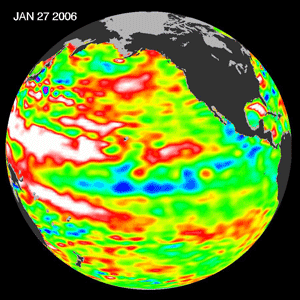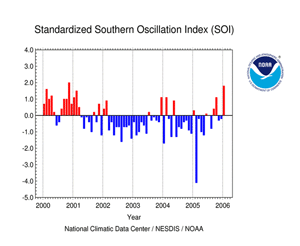LA NIÑA CONDITONS DEVELOP:
SST ANOMALIES COOL ACROSS THE EQUATORIAL PACIFIC
SST ANOMALIES COOL ACROSS THE EQUATORIAL PACIFIC
|
|
Sea-Surface
Temperatures (SSTs) and
Mixed-Layer Conditions: SSTs decreased across the equatorial Pacific Ocean in January. The trends in the observed SST anomalies during January were declining relative to the long-term means in the central and western parts of the tropical Pacific basin, while in the eastern Pacific the SST anomalies had actually increased to near-normal by the end of the month in the Niño 1+2 region. In the mixed-layer, below average water temperatures persisted in the eastern and central Pacific, with the largest monthly anomalies between -2 to -3°C centered near 140°W and at ~100 m depth. In the central equatorial Pacific, the SST anomaly in the Niño 3.4 Index region decreased to -1.09°C (-1.96°F) below the mean. The western Pacific SST anomaly decreased as well, with a monthly averaged Niño 4 Index of -0.42°C (-0.76°F) (map of Niño regions). For the most recent ocean surface temperature conditions, please see the loop of satellite-derived weekly SST anomalies for January 2006. Below average SST anomalies have persisted throughout the latter half of 2005 and into January 2006 in the eastern and central equatorial Pacific basin, and this can be seen in the data from NCDC's Extended Reconstructed Sea Surface Temperature dataset (ERSST version 2). Due to the decreases in the monthly averaged SSTs, the 3-month running mean of the Niño 3.4 Index declined below -0.5°C in January. (NOTE: A running 3-month mean SST anomaly below -0.5°C in the Niño 3.4 region is a significant indicator that a La Niña is occurring. For the NOAA's official ENSO classification scheme, please see NOAA's El Niño/La Niña Index Definition and see the CPC ENSO Diagnostic Discussion for NOAA's latest official assessment of ENSO conditions.) |
|
|
Equatorial Zonal
Winds (U-Component Winds) and Sea-Level Topography: The easterly trade winds were above normal across much of the central and western equatorial Pacific basin during January, with the largest easterly wind anomalies developing in the western Pacific during the month. The stronger-than-average trade winds increased equatorial upwelling in the mixed-layer, which led to the observed decreases in the monthly averaged SSTs in both the Niño 3.4 and 4 regions. Satellite altimetry of ocean surface topography from the NASA/JPL Jason-1 satellite over the Pacific basin and global oceans is shown to the left. The most recent Pacific overpass of the Jason-1 satellite showed a number of large positive sea level anomalies in the southwest and northwest Pacific, most likely associated with enhanced tropical convection, while the negative anomalies that developed in the central equatorial Pacific during January are directly related to the cold SSTs associated with La Niña conditions (see the 27 January 2006 overpass). |
|
|
Outgoing
Longwave Radiation (OLR): The map to the left shows the spatial pattern of global OLR (in W m-2) observed by satellite during January. Positive OLR anomalies (typically associated with La Niña) have developed in the equatorial western Pacific region, centered near the dateline, as tropical convection was suppressed along the equator during January. The 3-month averaged OLR anomalies were also positive in the same region of the western Pacific basin near the dateline. In contrast, enhanced convection was observed further west in the Indonesian region, where large-scale tropical convection and several tropical cyclones have occurred in the past month. The monthly-averaged OLR Index value remained positive in January, with a value of +1.3 W m-2 averaged across an area centered over the dateline in the western Pacific between 160° E and 160° W (positive OLR Index values are typically associated with La Niña conditions). January was the sixth consecutive month with a positive OLR index value. Therefore, convection has been suppressed in the western and central equatorial Pacific, most likely in response to the below normal SST anomalies present along the equatorial zone. Note that high frequency variability in OLR is typically associated with the Madden-Julian Oscillation (MJO) (MJO related convective activity propagates west to east in the near-equatorial region from the Indian Ocean into the Pacific Ocean approximately every 30-60 days). The latest MJO activity can be seen in CPC's graphs of Daily MJO Indices. |
| Southern
Oscillation Index (SOI): The standardized SOI switched signs from negative to positive in January, with an average index value of +1.8 for the month (Note: positive SOI values are typically associated with La Niña conditions in the equatorial Pacific). This switch in sign followed several months during which the SOI had fluctuated several times between a near-neutral value and a more negative index that is typically associated with warm event conditions. Therefore, the recent change in sign to a positive SOI value in January suggests that the atmosphere has begun to respond to the below average SSTs during the development phase of the weak La Niña event. |
Additional Links
- ENSO Monitoring
- NOAA El Niño / La Niña Index Definition
- NOAA's Pacific Marine Environmental Laboratory (PMEL):
- NOAA's Climate Prediction Center (CPC):
- NOAA's Physical Science Laboratory
- NASA/JPL Ocean Surface Topography from Space
- Australian Bureau of Meteorology (BoM) Climate Driver Update
- IRI - International Research Institute
 NOAA's National Centers for Environmental Information
NOAA's National Centers for Environmental Information





 Larger image of
January OLR
Larger image of
January OLR Larger image
of Nov-Jan OLR
Larger image
of Nov-Jan OLR Larger image of
January OLR Index
Larger image of
January OLR Index